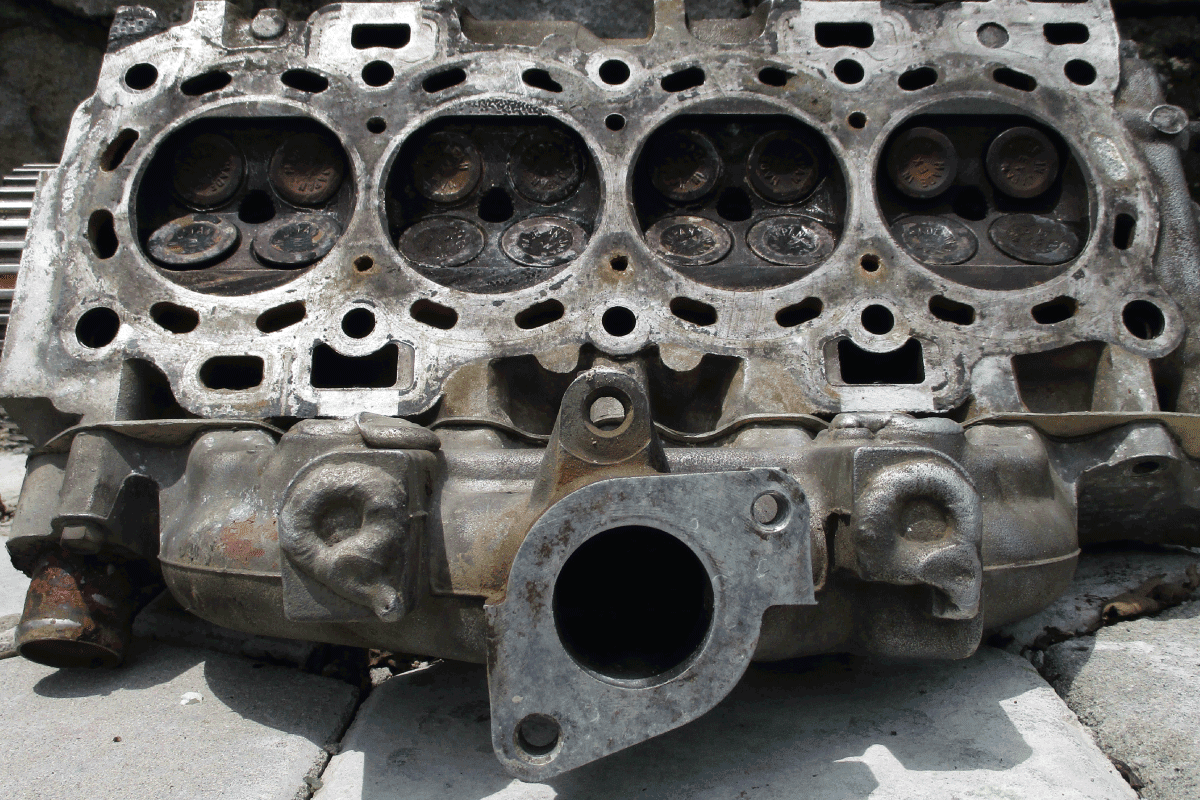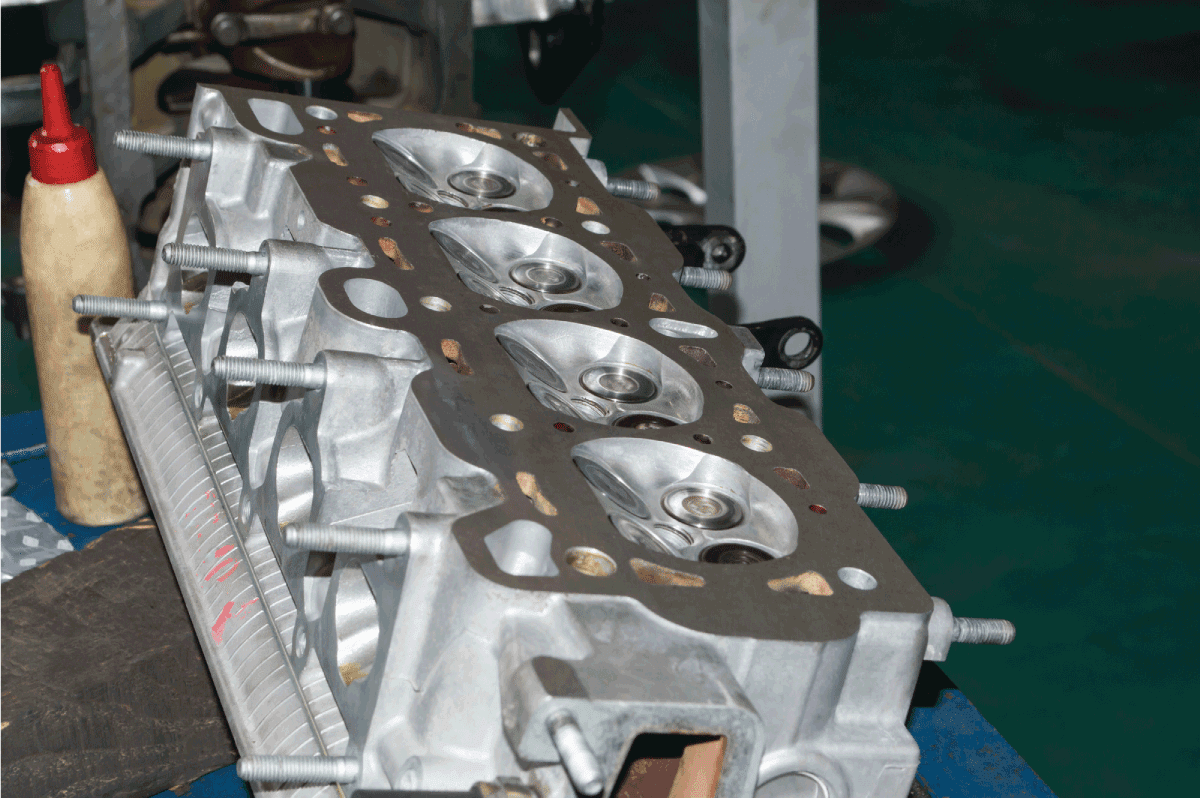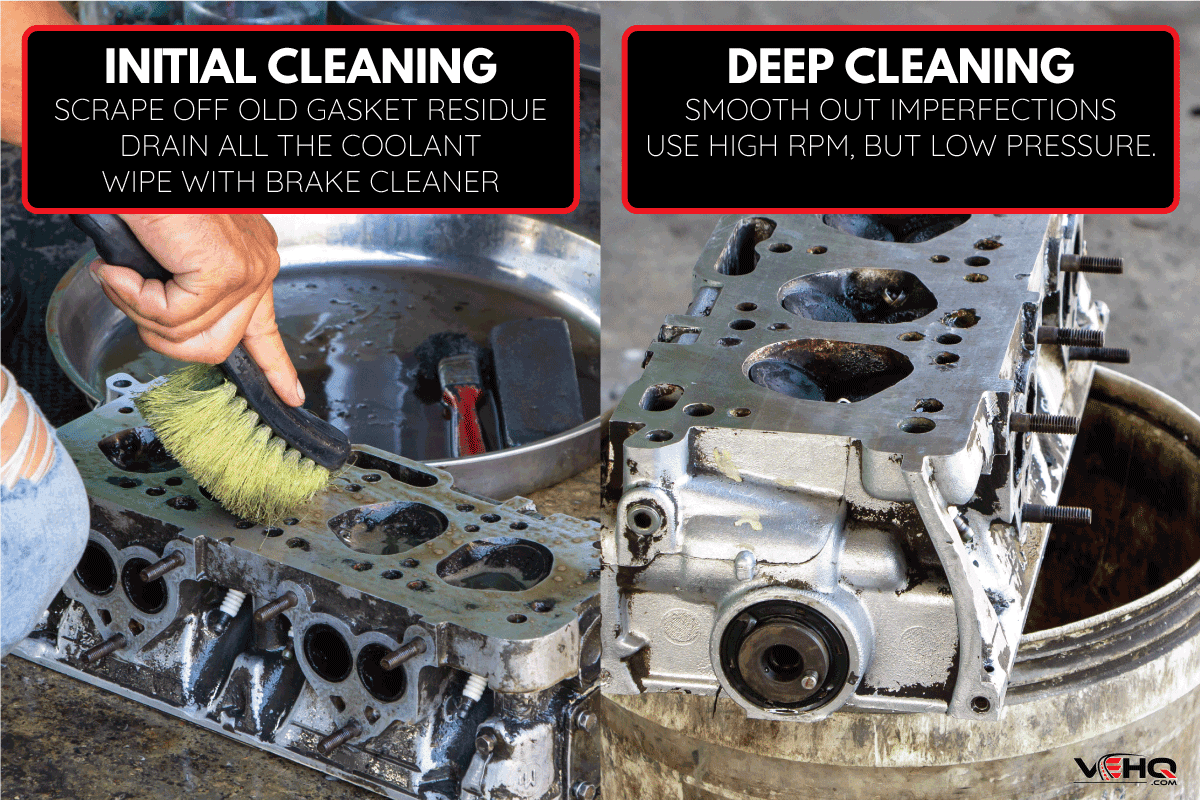Are you about to replace the head gasket of your car’s engine, and do you want to learn about the best ways to clean the head gasket surface? You’ve come to the right place, for we have researched this question, and we have the answer for you.
There are several ways to clean the head gasket surface. One method is to bring the cylinder head to a machine shop that shaves off a super thin layer of the head gasket surface. This makes it even and eliminates any residue from the old head gasket. Other methods of cleaning the head gasket surface include rotary bristles and using plastic and razor scrapers.
Let’s talk about each of these methods in the succeeding sections including when and how to use them.
Read on!
The Head Gasket
The head gasket has the important function of creating a seal between the cylinder head and the engine block.
An internal combustion engine has two major parts—the engine block and the cylinder head.
The cylinder head is the dome or roof that covers the combustion chamber. This solid block of metal has holes for the valves, fuel injectors, spark plugs, and camshaft. Cylinder heads can be cast iron or aluminum, and it does not have to be of the same material as the engine block.
The engine block, on the other hand, houses the rest of the engine that is not on the cylinder head. The engine block of a modern engine houses the combustion chamber where the combustion of the fuel and air mixture happens. It also has coolant tunnels, oil passages, and a crankcase.
Various fluids flow within the engine, which is important so that the engine will run properly. The coolant keeps the engine within safe operating temperatures and prevents it from overheating. The engine oil keeps the engine components lubricated to reduce engine wear.
The head gasket keeps these fluids separate, preventing them from mixing with each other. The head gasket also ensures that the pressures within the combustion chamber are kept within the combustion chamber only.
We’re always thinking about preventing pressure and liquids from getting out that we forget about preventing entry. Perhaps the least known purpose of the head gasket is to prevent dirt and air from getting inside the areas of the engine where you don’t want them.

Why is it necessary to clean the mating surface before fixing the gasket?
Cleaning the mating surfaces before you install a head gasket is important because it ensures that your new head gasket will make a proper seal.
Before sealing a surface—and this applies to any sealing surface in the engine, not just the head gasket—it is important to prepare the surface that you will seal. Cleaning the surface is part of the process of preparing for the seal. Dirt, grease, or residue from the old gasket will cause the new gasket to have uneven seating with the sealing surface. The uneven seating will create gaps in the seal.
Place your phone on a flat surface and try to see through the area where your phone contacts the flat surface. You couldn’t, right?
Now place a pencil on the flat surface and let one end of your phone rest on the pencil. This time, you’d be able to see through the surface where your phone and the flat surface should meet.
In this example, the pencil represents the dirt and residue from the old gasket.
Whenever you clean any mating surface on your engine, it is important to understand that you have two objectives. The first objective is obvious—you need to get rid of any dirt that is on the mating surfaces before you install the new gasket.
The second objective is less obvious. You also need to make sure that you’re not going to scrape, gouge, or deeply scratch the head gasket surface. While you need to get the surface clean, you also need to maintain its level surface.
Imperfections on the surface will also become a passageway for leaks to happen. Fluids and gas will use this to get out.
How to clean a head gasket surface?
Before cleaning a head gasket surface, it is important to identify the material that you’re cleaning. It is not uncommon in modern engines to have a different material for the cylinder head and the engine block.
When you need to work on two different materials, you will have to adapt your cleaning technique to the material that you will work on.

How to identify if you have an aluminum or cast-iron head or block?
The easiest way to identify if you’re dealing with a cast-iron part is to use a magnet. Use a strong magnet to make sure that it will not be affected by any dirt build-up on the engine.
If the magnet doesn’t stick to the engine, then it is aluminum. If the magnet sticks, then it is cast iron.
Make sure to test both the cylinder head and the engine block. Your engine could have different materials for both.

Initial Cleaning
Cleaning the head gasket surface starts with getting rid of the old head gasket. Once you separate the cylinder head from the engine block, you will be able to remove most of the old head gasket. However, you will notice that there will be residue left on the mating surface.
You can scrape off this residue with a scraper.
However, before doing any scraping, fill the cylinder holes with as much rug as you can to prevent any residue or dirt that you remove from falling into those holes. You don’t want those residues in your combustion chamber.
Alternatively, you can have a vacuum cleaner running while you scrape the dirt off the mating surfaces so that it will suck in any dirt that you get rid of before it falls into the cylinder holes.
Another important preparation that you need to do is to suck any existing coolant that is still inside the coolant channels. You can use a turkey baster to suck the coolant out. This procedure will prevent the coolant from spilling over to the areas of the engine where it should not be when you’re cleaning the mating surfaces.
Use a razor scraper on a cast iron engine block or cylinder head. Keep the razor tip of the scraper at a 90-degree angle with the surface that you’re cleaning. This will prevent any possible scratches that the scraper can cause on the surface.
Use a plastic scraper for aluminum engine blocks or cylinder heads. Aluminum is softer, and using a razor scraper on aluminum can easily scrape it.
After you remove all the large residue, get a rag, and wet it with brake cleaner. Wipe the surface with the wet rag.
CRC BRAKLEEN Brake Parts Cleaner is available on Amazon through this link.
2PACK Razor Blade Scraper is available on Amazon through this link.
Deep Cleaning
After you get rid of the solid residue from the old head gasket, it is time to inspect the mating surfaces. If you notice shallow cracks, deep scratches, or any imperfection that makes the surface around holes less than level, you should take your engine to a machine shop for resurfacing. These damages and imperfections will cause the head gasket to improperly seal.
A machine shop can make the imperfection or damage on the mating surfaces go away. If the scratch or damage is too deep, even a machine shop might not be able to fix it.
However, if there are no visible imperfections on the surfaces around the holes, then you can do a deep cleaning yourself.
Use a 50-grit bristle disk on an iron surface and a 120-grit bristle disk on an aluminum surface. This is like a toothbrush with thicker bristles that you can mount on a rotary power tool.
Keep in mind when using bristle disks to use a high RPM but low pressure. Additionally, you should never keep the bristle disk on the same surface for a long time. Always keep it moving.
This should remove any leftover dirt that the scrapers were not able to remove.
Focus on the edges of the holes. These are the sealing surfaces that seal the chambers and channels with the head gasket.
Never use wire brushes or sanding surfaces to do a deep cleaning. These tools can create unevenness on the surface that will negatively affect the seal.
3M-18733 Roloc Bristle Disc Grade 120 is available on Amazon through this link.
3M-18734 Roloc Bristle Disc Grade 50 is available on Amazon through this link.
Completing The Cleaning Process
Get a rag and soak it with brake cleaner. Wipe the surface with the rag thoroughly to get rid of any residue.
Use a vacuum cleaner to suck any debris from the holes, then remove the rags inside.
Check any manufacturer recommendations for sprays or compounds that should be applied on the head gasket surface or to the head gasket itself. These compounds are used to improve the seal that the head gasket makes, but not all manufacturers have any recommendations.
![short block engine with installed head gasket. How To Clean A Head Gasket Surface [Best Ways!]](https://vehq.com/wp-content/uploads/2022/11/short-block-engine-with-installed-head-gasket.-How-To-Clean-A-Head-Gasket-Surface-Best-Ways.png)
Conclusion
Cleaning the head gasket surface is important to create a perfect seal. It is important when cleaning to identify if you have an aluminum or cast iron and adapt the cleaning method to the material.
If you found this article interesting, why not check the two articles below too:
How To Fix A Blown Head Gasket Without Replacing It [Step By Step Guide]
How To Use Blue Devil Head Gasket Sealer [With Or Without Radiator Cap]?




